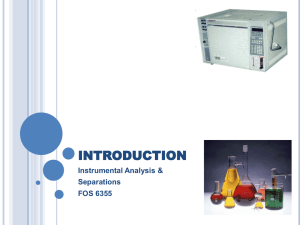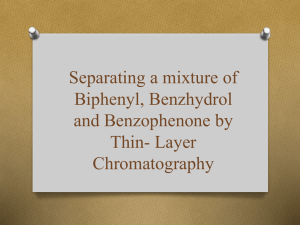The Bali Bombings of 2002
advertisement
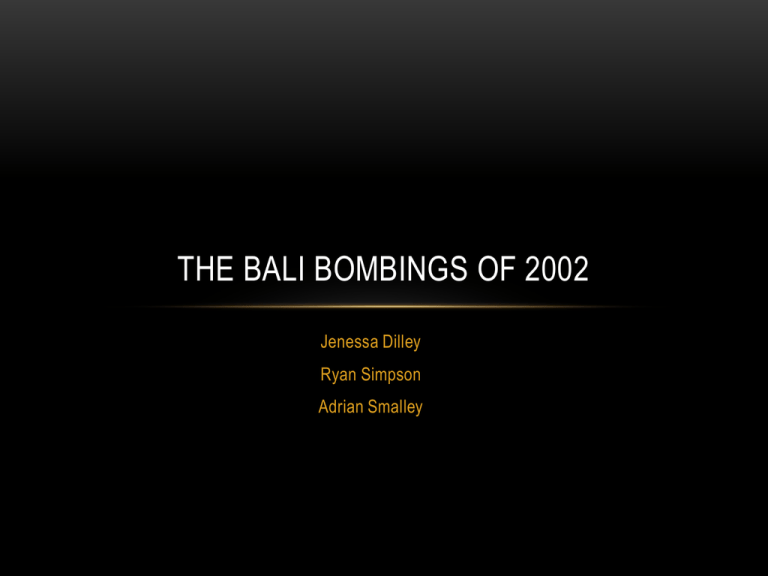
THE BALI BOMBINGS OF 2002 Jenessa Dilley Ryan Simpson Adrian Smalley A NOTE ON STATISTICS • Statistics in the form of analysis of variance helps to reveal the underlying causes of poor precision. Even more important is to reveal a weakness in the trueness. The aim of any chemical analysis is to determine the true value of the sample to achieve accuracy. It would be that we measure extremely precisely, that is, we observe a very low variance. That does not mean that we have determined the true value for the sample. Perhaps, we made a mistake during sample preparation. If only a single sample is prepared, the sample preparation error is an error in the trueness. Therefore, it is necessary to process several subsamples to obtain a representative estimate of the true value of an analyte. • The error in trueness is the difference between the measured value and the true value for the sample • A single measurement value never reveals a random error, and a single incorrectly functioning measurement can never reveal a lack in trueness • Measuring small concentrations will generally result in large variance • To check accuracy we therefore have to carry out multiple error-dependent steps on the way to the final result ORTHOGONAL TESTING (REPRODUCIBILITY) • A satisfactory level of confidence in establishing the identity of a questioned sample is generally achieved after corroboration from two independent techniques • This is known as orthogonal testing • The level of confidence rises with each positive result • Orthogonal testing is relatively easy to achieve when dealing with bulk material • It is more difficult when dealing with trace quantities, especially those from an inorganic source which may occur naturally in the environment, or if they are volatile and unlikely to persist in the area • “Time of flight mass spectrometry can get past the problem of thermal instability by performing very rapid analyses using a short narrow bore column, and de-convoluting the resulting chromatogram by exceedingly rapid mass spectral analysis. This however raises the question as to whether it is truly orthogonal testing for if the chromatography does not resolve co-eluting compounds, then is it really only the one technique?“ METHODS & TECHNIQUES • The following slides highlight the methods and techniques used in the analysis of the Bali Bombing of 2002 • Some of the errors associated with the experiments may be increased if the following practices are not implemented • Careful technique (accuracy) • Setting experimental parameters • Controlling the environment • Following standard operating procedures • Reducing sample exposure to contaminants • Etc. THIN LAYER CHROMATOGRAPHY (TLC) • All chromatographic techniques flow the mixture, that is to be separated, through a material that retains some components more than others • Different compounds in the sample mixture travel at different rates due to the difference in their attraction to the stationary phase, and due to their differences in solubility in the solvent • This causes different components to flow through the material at different speeds, so they separate • TLC was used to test for organic explosives • Ex. TNT, RDX, PETN THIN LAYER CHROMATOGRAPHY (TLC) • Limitations: • Low resolution susceptible to contamination • Open system, can contribute to the statistical error • The spotted plate is normally dried before development. • The drying step can be a big, unpredictable source of error. If too much heat is used, spots can remain at the start and samples or standard can be degraded • During the drying process, the mobile phase evaporates from the upper part of a plate and produces secondary chromatography, which is the main reason for poor precision in TLC • Uncontrolled separation conditions produce poor reproducibility • Spraying with a special reagent is commonly used to allow for visualization of components, which have no chromophore • This technique is less reproducible than dipping of the plate, which is a strictly empirical operation GAS CHROMATOGRAPHY (GC) • GC is a common type of chromatography used in analytical chemistry for separating and analyzing compounds that can be vaporized without decomposition • As the chemicals exit the end of the column, they are detected and identified electronically. The function of the stationary phase in the column is to separate different components, causing each one to exit the column at a different time (retention time). Other parameters that can be used to alter the order or time of retention are the carrier gas flow rate, column length and the temperature • It can be used to test the purity of a particular substance, separate the different components of a mixture and even determine the relative amounts of such components • In some situations, GC may help in identifying a compound • Various detectors can be used some of which are sensitive to a wide range of components, and work over a wide range of concentrations and others which are sensitive to only specific types of substances and/or work well in narrower ranges of concentrations • GC was used to test for nitrogen-containing, nitro-containing and organic explosives • Ex. TNT, RDX GAS CHROMATOGRAPHY (GC) • Limitations • Requires volatile analytes • Incorrect integration • Especially false data density, false integration start and stop because of poor peak detection, false base line positioning. There are further error sources in quite some - even latest commercial - integration software like missing signal size analysis and missing or poor automatic switching of data density with growing retention time • If the temperature is too low, substances may not elute during the time the instrument or the detection / integration is on. This falsifies the analytical results drastically and may damage the separation system, at least may change the polarity or selectivity of the stationary phase. • If the temperature is too high this may cause peak overlapping of early eluting substances and reduce the life time of the separation system. GAS CHROMATOGRAPHY WITH ELECTRON CAPTURE DETECTOR (GC-ECD) • Refer to GC • An ECD is a device for detecting atoms and molecules in a gas through the attachment of electrons via electron capture ionization and is used in gas chromatography to detect trace amounts of chemical compounds in a sample • Limitations: • Requires volatile analytes insensitive to hydrocarbons • ECD has a limited dynamic range and finds its greatest application in analysis of halogenated compounds GAS CHROMATOGRAPHY WITH THERMAL ENERGY ANALYZER (GC-TEA) • Refer to GC • The TEA is an N-nitroso detector that is based on the catalytic cleavage of the thermally labile N-NO bond and the subsequent detection of the nitrosyl radical by its reaction with ozone. The TEA can be interfaced to a gas chromatograph for volatile N-nitroso compound analysis • Limitations: • Requires volatile analytes • Expensive • Limited to nitro compounds • Requires optimal conditions involving temperature, pressure and residence time in order to achieve maximum sensitivity with minimum possible interference HIGH PERFORMANCE LIQUID CHROMATOGRAPHY WITH UV OR DA DETECTION (HPLC-UV OR DA) • HPLC has higher resolution when related to TLC • UV detectors measure absorption of radiation from chromosphere’s in eluted compounds over the range 190-400nm • Limitations: • Low selectivity • It is not selective for compounds if they absorb at the same wavelength INFRARED SPECTROSCOPY (IR) • IR is the spectroscopy that deals with the infrared region of the electromagnetic spectrum, that is light with a longer wavelength and lower frequency than visible light. It covers a range of techniques, mostly based on absorption spectroscopy. • Limitations: • Residues require separation prior to analysis • Looks for functional groups (ketones, alcohol, etc.) in molecules to help determine their components and structure. Functional groups do not dictate what molecule is being detected • It is used universally for organic and inorganic compounds. (Not exclusive) • Radiation Curves: Certain bands of radiation located near the IR spectrum may not be clearly defined and can therefore be hard to determine and analyze. This can lead to confusion and cause overlap of the signals to give difficult results to read off of the instrument. Due to this lots of calibration and tuning is required to set the instrument for each individual test MASS SPECTROSCOPY (MS) • MS is an analytical technique that measures the mass-to-charge-ratio of charged particles • Used for determining masses of particles, for determining the elemental composition of a sample or molecule, and for elucidating the chemical structures of molecules, such as peptides and other chemical compounds • Limitations: • Doesn't directly give structural information • Needs pure compounds • No contamination • Difficult with non-volatile compounds GAS CHROMATOGRAPHY WITH MASS SPECTROMETRY (GC-MS) • Refer to GC • Refer to MS • Limitations: • Limited to volatiles • The experimental conditions, such as temperature, pressure, carrier gas flow rates, etc. must be identical to those used to analyze the specimen • Due to the investigation occurs on the day preceding the bombing, it is more than likely that the volatile substances would have been contaminated • Also, similar compounds have similar retention times which can be mistaken SCANNING ELECTRON MICROSCOPE /ENERGY DISPERSIVE X-RAY (SEM/EDX) • Limitations: • Was unable to detect sulphur from the explosion • “Although high explosives are used to initiate and boost low explosives, they are usually totally consumed in the ensuing reaction and rarely leave traces for the forensic chemist to find...” ASSUMPTIONS/FLAWS • “In order to mount an argument that an inorganic ion was part of the explosive mixture, the forensic analyst must demonstrate its concentration to be significantly higher in and around the crater than in the background.” • “A large number of analyses may be required to achieve this objective.” • “At this stage of technological development there are no instruments available on the market for such applications” • “Soils from in and around the blast seat were analyzed by scientists from the AFP using X-ray fluorescence spectroscopy. No evidence was found to indicate higher than background levels of any of the elements implicated.” • “Although high explosives are used to initiate and boost low explosives, they are usually totally consumed in the ensuing reaction and rarely leave traces for the forensic chemist to find.” SAMPLING TECHNIQUES • Circumstances which may affect samples and therefore test results • Amount of sample collected • Exposure • Reaction with environment • Volatility • • Contamination • Time laps before testing of sample occurred • Long distance travel of sample • Etc. “The quantity of post blast residual matter was reduced through dissolution and being washed away down gutters and drains. The warm and humid climate of the tropics compounded the problem as atmospheric moisture combined with the fuels and carbonaceous materials to further reduce the amount of reactive chemicals to be found” DETERMINATION OF BACKGROUND LEVELS • Circumstances which may negatively effect the background reading with which samples are compared to • If the background reading is taken too far from the blast site it may not have an accurate depiction of the levels of various substances found in the area • If the background reading is taken too close to the blast site it may be contaminated with substances from the blast itself, thereby contaminating the sample and skewing data FLAWS IN USING A MOBILE LABORATORY • There is a fine line in determining how close to the scene a mobile lab should be as to be convenient, yet far enough away to minimize the risk of contamination • “The rationale behind a mobile laboratory is to produce timely, albeit tentative findings for the investigators whilst reducing the number and volume of samples to be sent to the main laboratory for more exhaustive confirmatory analyses” • These tests are not conclusive and if there are findings it only allows for further testing • These test are also not very accurate, which means there may be false positives, but also false negatives. False positives would most likely be followed up on, but false negatives may not be as the mobile lab would determine them to be not as important • If there are already trace amounts of substances and contamination present doing these tentative tests may limit the amount of material left for more conclusive test to be ran and may cause further contamination of the sample, thereby hindering rather than furthering the investigation CONCLUSION • These techniques and methods were not accurate enough to draw the conclusions that the forensics team had done in this investigation. They were informed of important details from the suspect that confessed and worked backwards using this information. If they had not been supplied with this information, more careful techniques would need to be employed to determine key aspects of the case (such as bomb materials, amounts, etc.) • A more careful analysis would aid the investigation • Ex. Bombing materials used, check for recent purchases, etc. • These types of careful analysis were not required as the team “got lucky” off of the van code that was traced back the the suspect which confessed and aided in the discovery of substances and amounts used in the bombs from which the forensic team then tentatively confirmed
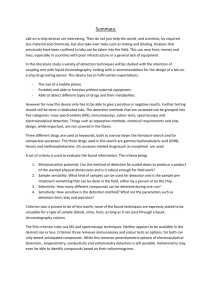


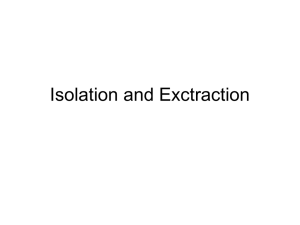
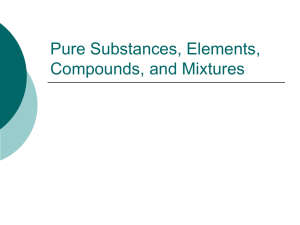
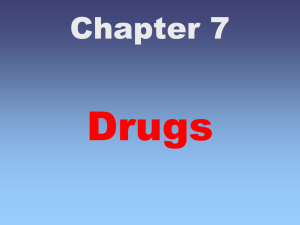
![Chem 3 Elements, Compounds, and Mixtures PPT [11/15/2013]](http://s2.studylib.net/store/data/005796663_1-9247eb9205249afa1115390decddad23-300x300.png)
